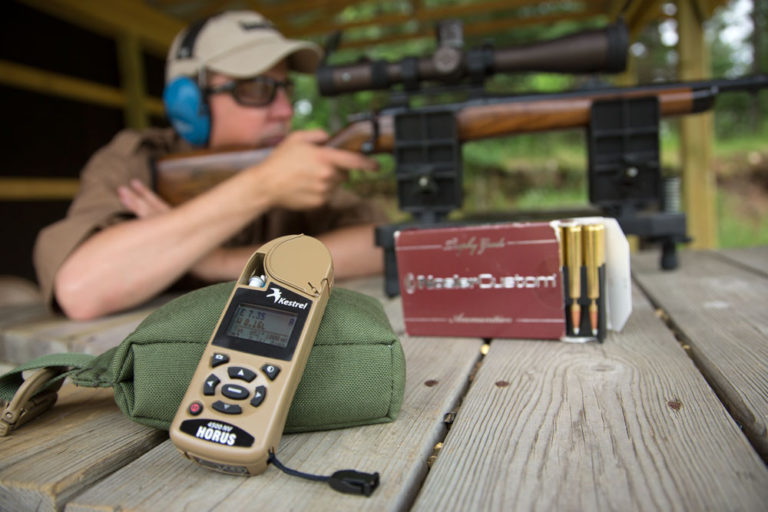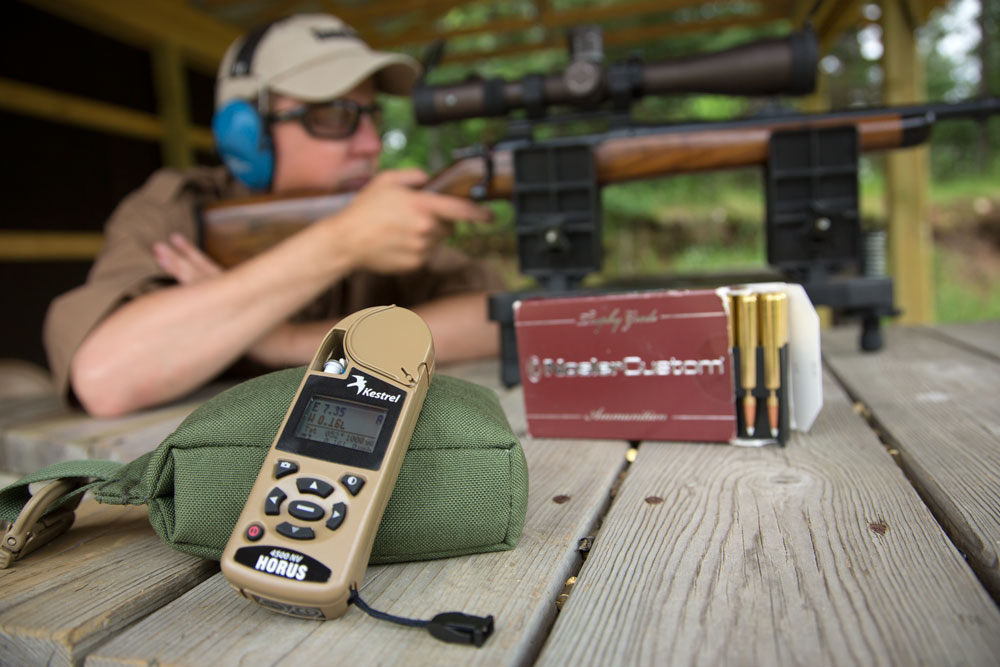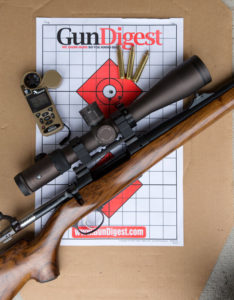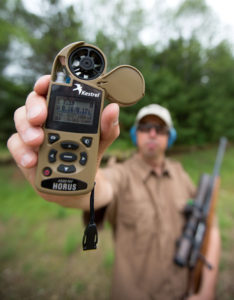

The Kestrel 4500 NV from Nielsen-Kellerman is a do-it-all weather meter with full on board ballistics that takes the guesswork out of shooting, allowing you to dial in precisely to make truly long-range shots.
 I’m on the bench, range to target is known. Peering through the scope, little wavy thermal lines rise up from the earth, dancing like gypsies in a carnival caravan. Forty-five degrees, I think to myself, noting the thermals’ angle to earth. I see there is moderate leaf action on the trees and I estimate the wind: 10-15 miles per hour full crosswind value. Click, click. Send it.
I’m on the bench, range to target is known. Peering through the scope, little wavy thermal lines rise up from the earth, dancing like gypsies in a carnival caravan. Forty-five degrees, I think to myself, noting the thermals’ angle to earth. I see there is moderate leaf action on the trees and I estimate the wind: 10-15 miles per hour full crosswind value. Click, click. Send it.
And it’s a miss.
Wind estimation is both a science and an art and it can be a tough nut to crack. Super bullets can help buck the wind but they will only get you so far. “No matter how well your bullet resists wind,” writes Wayne van Zwoll in Mastering the Art of Long-Range Shooting, “hitting at distance depends on your ability to predict drift.”
One way to predict drift is by good ol’ fashioned wind estimation techniques in the field. Another way is to use a calculator. And the gold standard of calculators, the one you must have if you want to ratchet up your long-distance shooting game, is the Kestrel 4500 NV weather meter with built-in ballistics (Horus Vision or Applied Ballistics) software.
Nothing compares when trying to place a tiny super-sonic missile on a pie plate ten football fields away. Indeed, that’s a challenging enough feat if you know all the variables, let alone if you’re just guessing.
Features
The Kestrel 4500 NV is a handheld mobile weather station. The unit I tested was the Horus Vision ATRAG model, which provides what can only be described as a staggering amount of ballistic calculation in a tiny package.
Among other things, you can set up and save any number of guns and cartridge combinations. When setting up a new gun, parameters include Muzzle Velocity (MV); Drag Curves or DC (G1, G7); Ballistic Coefficient (BC); Bullet Weight (BW); Bullet Diameter (BD); Bullet Length (BL); Zero Range or ZR (109 yards, 100 meters is default); Bore Height or BH (middle of bore to middle of scope); Rifle Twist (RT); Rifle Twist Direction (RTd); Elevation Unit or eUnit (mil, true moa, shooter moa, click value) and Calibrate muzzle velocity (CMV), a truing feature based on actual observed field data. You can also input inclination and declination—to compensate for angle shooting up or down.
Unless you’re a caveman, you’ll get the hang of the Kestrel’s menu fairly quickly, though admittedly there are a ton of things packed into this device. Speaking of Horus Vision vs. Applied Ballistics, you can order the Kestrel configured with either. Space doesn’t permit a full discussion here of the differences but both programs are completely capable. Stay tuned for further reports on the software differences.
Real-Time Wind Correction
The Kestrel reads wind in real time. Instead of trying to estimate wind by reading the trees or inputting a general or average wind value into a unit based on a meteorologist’s report, the Kestrel measures and updates the firing solution values in real time. The unit displays minimum and maximum wind values while calculations happen behind the scenes—saving time and effort in the field so you can concentrate on the fundamentals of the shot itself.
I was really impressed by the “W>,” or Wind function, which gives you firing solutions based on the cardinal direction—that is, the angle to the wind—you're shooting. This calculates crosswind, while automatically updating the firing solutions for any angle off of the locked-in direction. To use, just hold in the direction of the wind and “lock it” by using the camera button on the front.
Coriolis Effect
Coriolis, or the effect of Earth's spin during the time your bullet is in flight, is calculated from the Latitude setting in the Environment menu. Latitude is something you have to enter as the Kestrel cannot measure this. Needless to say, the Kestrel makes adjustment for Coriolis so easy even I can do it.
Range Card
 The built-in range card feature is a powerful application in and of itself. You can set the range increments—50 yards is default—and it will spit out your dope, including moving target solutions. The Range Card also delineates transonic and subsonic muzzle velocity at various ranges. It's amazing how much you can learn about how your loads perform in the real world from this tiny yet very powerful device.
The built-in range card feature is a powerful application in and of itself. You can set the range increments—50 yards is default—and it will spit out your dope, including moving target solutions. The Range Card also delineates transonic and subsonic muzzle velocity at various ranges. It's amazing how much you can learn about how your loads perform in the real world from this tiny yet very powerful device.
The Range Card even depicts data and holdover solutions for moving targets with target direction (to compensate for wind angles) and target speed. In fact, you can designate individual targets and switch them on or off as you engage them. It includes a slew of variables you can input; just make sure you select “Active” to switch the Kestrel into that specific target mode. And turn off when you go back to general firing solutions.
Dope Aplenty
The Kestrel's sensors pick up environmental conditions like altitude above sea level, relative humidity, barometric pressure, absolute or station pressure (SP), air temperature and of course real-time wind.
The most confusing aspect of the device relates to pressure and altitude.”Essentially, it does not matter what you set on the weather side for reference alt and reference baro,” said Joe Racosky, Support Engineer with Nielsen-Kellerman. “The ballistics side will always be using the correct number. Ballistic solutions want station pressure, not barometric pressure. Station pressure is the pressure felt at that spot (station) without adjusting it for altitude. This is the same pressure that the bullet feels when fired. So if the user is curious as to what their station pressure is, they can leave the REF ALT to zero. And if the user is curious as to what their current altitude is, they can enter the local barometric pressure as their REF BARO.
“But this has no effect on anything on the ballistics side. And another confusing point for users is that density altitude does not depend on the altitude measurement. DA is from temperature, humidity and station pressure—which it will always use no matter what,” he explained.
Basically, the Kestrel gives you environmental readings if you want or need to know them, but the ballistic solver always reads actual Station Pressure and Density Altitude—automatically generating correct ballistic solutions. So it's really very simple: Don't do anything; just trust the Kestrel and you're on the money.
Ballistic Truing

Even if you don't have a chronograph you can still sync your Kestrel to your gun and load for spot-on use by using the Kestrel’s ballistic truing option. You input all the variables you do know, shoot at the range and measure actual bullet drop. Then simply input your range results to “true” the unit's data to your gun. This will not only give you the calculated muzzle velocity but will precisely tailor the Kestrel to your actual ballistic situation—what your gun really does in the real world.
Value
Now, you can hold a device in your hand that will not only read the weather and environmental conditions where you are, but also update a ballistics engine finely tuned to your bullet’s performance: giving you information you can use to hit distant targets that are barely visible to the naked eye.
The Kestrel 4500 NV is a steal when you consider everything you’re getting. After having used it, I can’t imagine shooting at really extended ranges without one. It's like several units in one all working seamlessly together. To my mind, that means fewer gadgets to carry, making me more efficient and allowing me to do my part behind the rifle. The unit grabs the atmospherics, and updates the firing solutions for you. What more do you need?
Conclusion
I’m on the bench again, and the little Kestrel’s impellor is whirring and buzzing in the wind. 7.5 … 9.7 … 11.2 … 8.4. Calculate. A firing solution is on screen. I grab the scope’s windage turret. Click, click. Squeeze the trigger. I look through the wavering mirage, this time not to estimate the wind, but to examine the target. A little black hole is seen, dead center mass. They say knowledge is power. I say knowledge is hitting your target. And that’s no guess.

Next Step: Get your FREE Printable Target Pack
Enhance your shooting precision with our 62 MOA Targets, perfect for rifles and handguns. Crafted in collaboration with Storm Tactical for accuracy and versatility.
Subscribe to the Gun Digest email newsletter and get your downloadable target pack sent straight to your inbox. Stay updated with the latest firearms info in the industry.

![Best Concealed Carry Guns In 2025 [Field Tested] Wilson Combat EDC X9S 1](https://gundigest.com/wp-content/uploads/Wilson-Combat-EDC-X9S-1-324x160.jpg)


![Best 9mm Carbine: Affordable PCCs [Tested] Ruger Carbine Shooting](https://gundigest.com/wp-content/uploads/Ruger-Carbine-Shooting-100x70.jpg)
![Best AR-15: Top Options Available Today [Field Tested] Harrington and Richardson PSA XM177E2 feature](https://gundigest.com/wp-content/uploads/Harrington-and-Richardson-PSA-XM177E2-feature-100x70.jpg)
